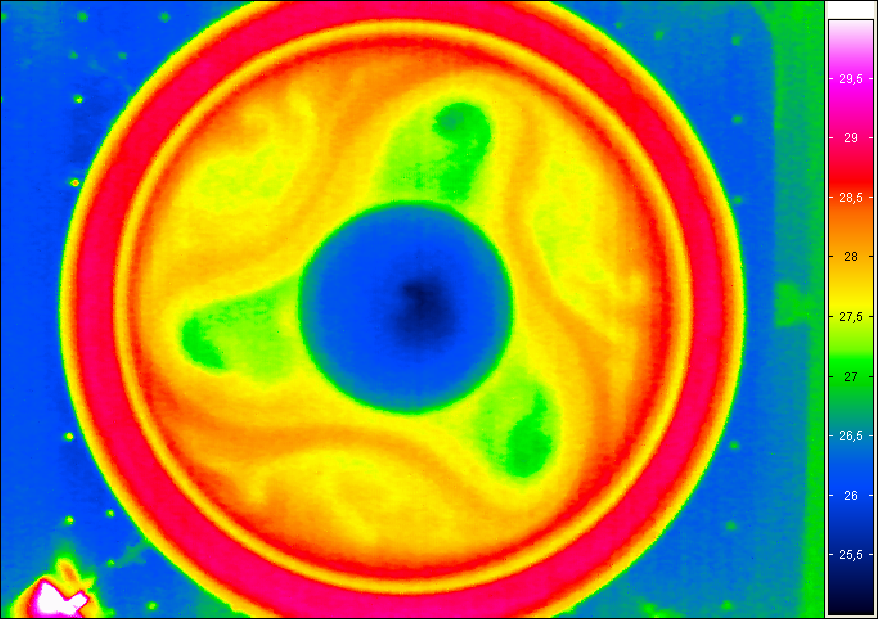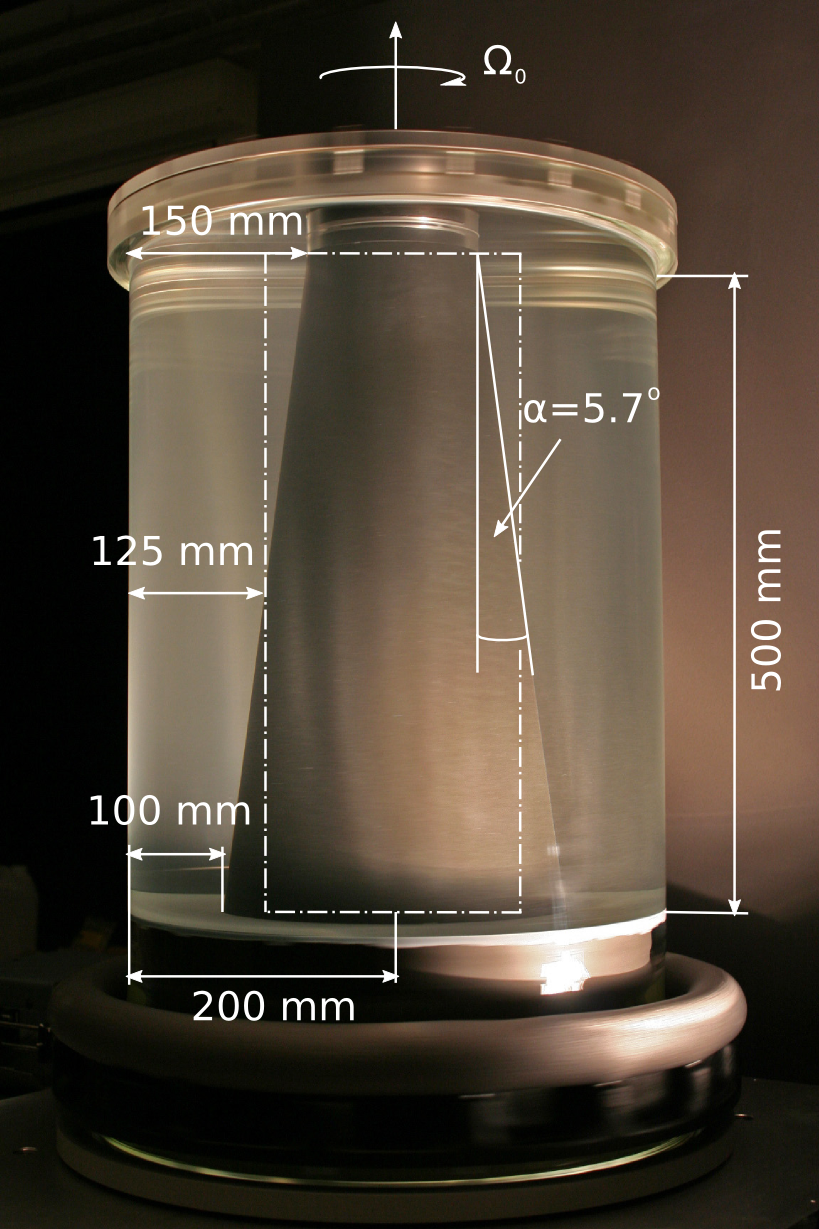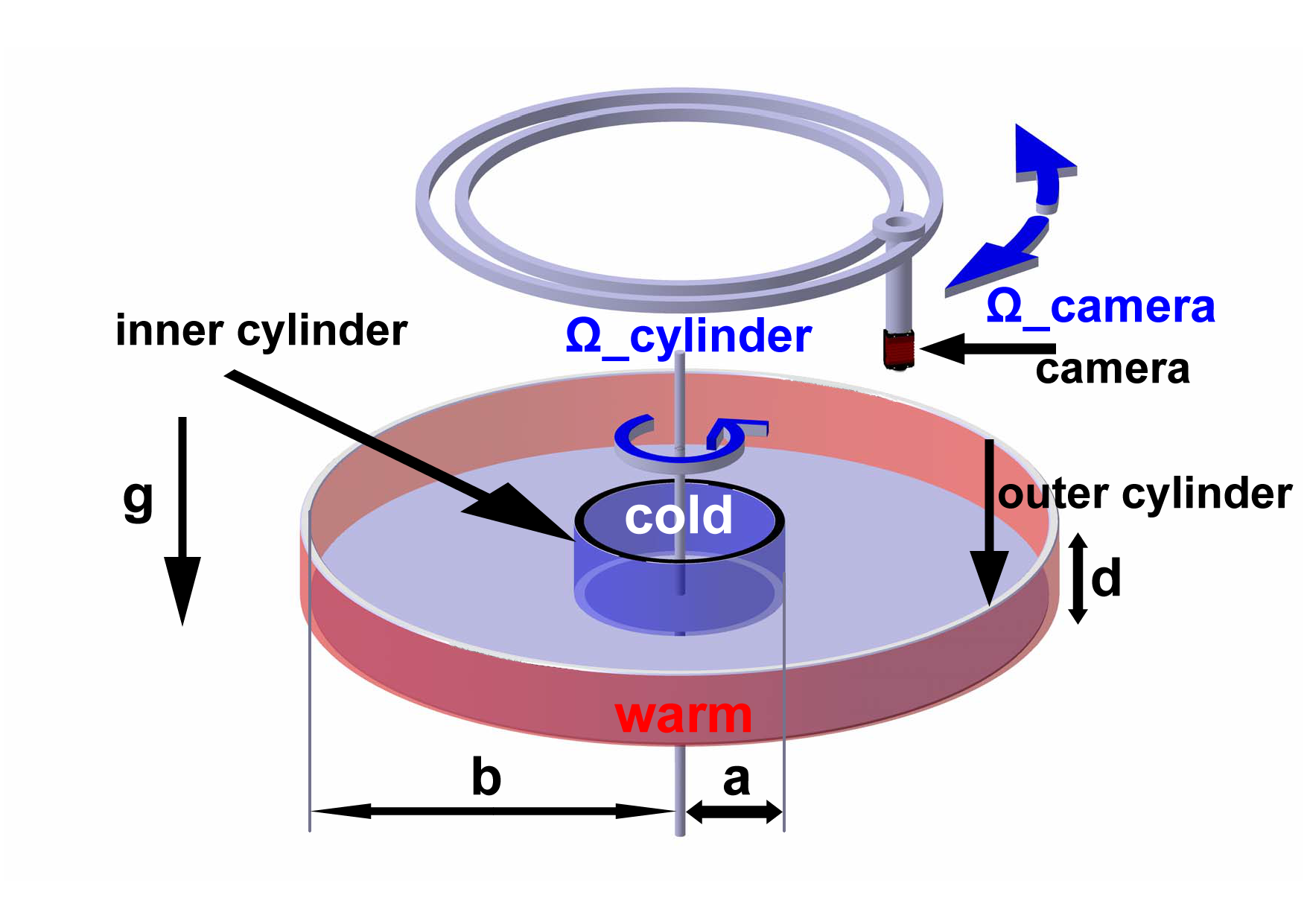
In recent years my GFD group got funding for the following projects
| title | MetStroem | baroclinic wave |
|---|---|---|
| "Reference experiment to study the dynamics and coexistence of multiple-scale structure in a baroclinic wave tank", DFG priority program 1276 MetStroem, 2008-2013. | The differentially heated rotating annulus is a widely studied tabletop-size laboratory model of the general mid-latitude atmospheric circulation. The two most relevant factors of cyclogenesis, namely rotation and meridional temperature gradient are quite well captured in this simple arrangement. The radial temperature difference in the cylindrical tank and its rotation rate can be set so that the isothermal surfaces in the bulk tilt, leading to the formation of baroclinic waves. The signatures of these waves at the free water surface have been analyzed via infrared thermography in a wide range of rotation rates (keeping the radial temperature difference constant) and under different initial conditions. In parallel to the laboratory experiments, five groups of the MetStroem collaboration have conducted numerical simulations in the same parameter regime using different approaches and solvers, and applying different initial conditions and perturbations. The experimentally and numerically obtained baroclinic wave patterns have been evaluated and compared in terms of their dominant wave modes, spatio-temporal variance properties and drift rates. Thus certain benchmarks have been created that can later be used as test cases for atmospheric numerical model validation (from Vincze et al., 2014, see publications). (more details see here) |

|
| title | inertial waves and mean flow | TC with frustum |
|---|---|---|
| "Mixing and mean flow generation by propagating inertial waves: theory, experiment, simulation", DFG funded, 2011-2013. | Zonal mean flow excitation by inertial waves is studied in analogy to mean flow excitation by gravity waves. In geophysical flows that are stratified and rotating, the two classes of waves correspond to the two limiting cases: gravity waves neglect rotation, inertial waves neglect stratification. The former are more relevant for fluids like the atmosphere, where stratification is dominant, the latter for the deep oceans or planet cores, where rotation dominates. In the present study waves are suggested to propagate in the meridional plane. A hierarchy of simple analytical and numerical models is considered and the results are compared with data from a laboratory experiment. The main findings can be summarised as follows: (i) when the waves are decoupled from the mean flow they just drive a retrograde (eastward) zonal mean flow, independent of the sign of the meridional phase speed; (ii) when coupling is present and the zonal mean flow is assumed to be steady, the waves can drive vertically alternating jets, but still, in contrast to the gravity wave case, the structure is independent of the sign of the meridional phase speed; (iii) when coupling is present and time-dependent zonal mean flows are considered the waves can drive vertically and temporarily oscillating mean flows. The comparison with laboratory data from a rotating annulus experiment shows a qualitative agreement. It appears that the experiment captures the basic elements of the inertial wave mean flow coupling. The results might be relevant to understand how the Equatorial Deep Jets can be maintained against dissipation, a process currently discussed controversially (from Seelig and Harlander, 2014, see publications). | 
|
| title | stratorotational instability | stratified TC |
|---|---|---|
| "Transport of angular momentum in a stratified Taylor-Couette experiment with applications to accretion disks", DFG funded, 2014-2016. | Thirty years ago it was observed that for many stars the emitted energy spectrum shows an extra bump in the infrared part. This infrared excess indicates a large gaseous disk encompassing the star. Such accretion disks are regions of planet formation. Understanding the mechanisms that can result in an outward angular momentum transport is the central problem of planet formation, particularly in the theory of accretion disks. When a planet forms in a disk, angular momentum has to be carried away from the planet otherwise its rotation speed would be far too large. Only turbulence can achieve such a large angular momentum transport (see the book by Armitage, 2009). For disks coupled to a magnetic field the Magneto Rotational Instability (MRI) occurs and, regardless of other angular momentum transport processes, one expects the fluid to sustain Magneto Hydrodynamic Turbulence. However, accretion disks can be turbulent even in the absence of a magnetic field, e.g. in regions where the ionization fraction is low. In such regions, the disk cannot be unstable due to MRI and it is an important question to ask whether other instabilities can excite turbulence there. Among other candidates the Stratorotational Instability (SRI) has attracted attention in recent years. The SRI is a purely hydrodynamic instability and much insight can be obtained from particularly designed laboratory experiments and numerical simulations in an axially-stratified Taylor-Couette setup (see Gellert and Ruediger, 2009). The SRI was experimentally studied by Le Bars and Le Gal (2007) using an axially salt stratified Taylor-Couette system. They found an excellent agreement with the linear stability analysis by Shalybkov et al. (2005). In the present project we use a Taylor-Couette apparatus (Fig.\ref{figure}b) where the fluid is axially stratified due to cooling the lower and heating the upper lid. Our system is three times as high as the one used by Le Mars and Le Gal and has a wider gap. We can reach Reynolds numbers between 300 and 30000. For Reynolds numbers smaller than 1000 we use oil (Prandtl number 60) and for numbers larger 1000 we use water (Prandtl number 7). |
| title | IGW and boundary layers | baroclinic wave |
|---|---|---|
| "Laboratory experiments and numerical simuations to characterize inertia-gravity waves in a baroclinic wave tank with an upper free surface", DAAD-Procope funded, 2012-2014. | In geophysical and astrophysical flows inertia-gravity waves (IGWs) play an important role. Due to wave breaking the waves can mix the fluid and they are considered to be a key element for sustaining the ocean's thermohaline circulation. Upward propagating IGWs can drive large-scale atmospheric flows and are responsible for the Quasi-Biennial-Oscillation of the equatorial stratosphere. For many years the dominant source for IGWs was supposed to be flow over topography. However, other sources came into focus, e.g. convectively generated IGWs and IGWs generated at jets and fronts. For the latter the waves are imbedded in a complex environment and a multitude of local instabilities plus spontaneous emission related to imbalance might be involved in the wave generation. From field data it is hard to entangle the different mechanisms since the complexity of the data is overwhelming. Such an entanglement however seems necessary for constructing parameterization schemes for spontaneously generated IGWs. In the project we compared data from a differentially heated annulus with the solutions from three different state of the are numerical models. In the lab experiment we find IGWs that are part of the baroclinic wave field. IGWs occur along the inner cold cylinder and it seems that they result from boundary layer instability (see Randriamampianina, 2013). However, the lab data as well as the numerical simulations also show wave signatures at the outer part of the baroclinic waves in the annulus. We suppose that the upper free surface of the baroclinic tank is essential for the occurrence of these waves. This project is a collaboration between the University Aix-Marseille (A. Randriamampianina, S. Viazzo), FU Berlin (Th. v. Larcher), and BTU Cottbus-Senftenberg (U. Harlander). | 
|
| title | spontaneous imbalance | experimental setup |
|---|---|---|
| "Spontaneous imbalance", part of DFG research unit MSGwaves, 2015-2017. | Large-scale balanced flows can spontaneously radiate meso-scale inertia-gravity waves (IGWs) and are thus in fact unbalanced. While flow-dependent parameterizations for the radiation of IGWs from orographic and convective sources do exist, the situation is less developed for spontaneously emitted IGWs. Observations identify increased IGW activity in the vicinity of jet exit regions. A direct interpretation of those based on geostrophic adjustment might be tempting. However, directly applying this concept to the parameterization of spontaneous imbalance is difficult since the dynamics itself is continuously re-establishing an unbalanced flow which then sheds imbalances by GW radiation. An important step forward was done by Ford (1994) who successfully applied the concept of "Lighthill radiation" to inertia-gravity waves radiated from vortices in shallow-water flow. Nonetheless, an essential assumption for this theory is that the wave scales are considerably longer than those of the source region. This assumption is violated for IGW radiation from jet streams. Recent work indicates that much of the process can be understood on a tangent-linear basis where GWs are predicted from a system obtained after linearization about the geostrophic flow, but also forced nonlinearly by the latter. Examining spontaneous IGW emission in the atmosphere and validating parameterization schemes confronts the scientist with particular challenges. Due to its extreme complexity, GW emission will always be embedded in the interaction of a multitude of interdependent processes, many of which are hardly detectable from analysis or campaign data. The benefits of repeated and more detailed measurements, while representing the only source of information about the real atmosphere, are limited by the non-repeatability of an atmospheric situation. The same event never occurs twice. This argues for complementary laboratory experiments, which can provide a more focused dialogue between experiment and theory. Indeed, life cycles are also examined in rotating-annulus laboratory experiments. Thus, these experiments might form a useful empirical benchmark for theoretical and modeling work that is also independent of any sort of subgrid model. In addition, the more direct correspondence between experimental and model data and the data reproducibility makes lab experiments a powerful testbed for parameterizations. This project is part of the DFG research unit and we collaborate with Ulrich Achatz (Goethe-University Frankfurt), Christoph Zuelicke (IAP-Kuehlungsborn), and Ilia Horenko (University of Lugano, Switzerland). | 
|